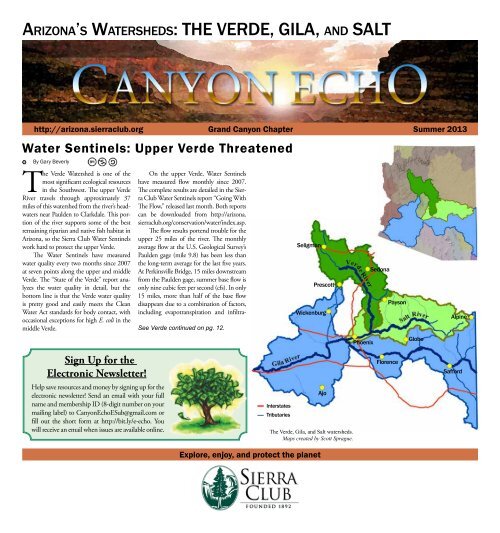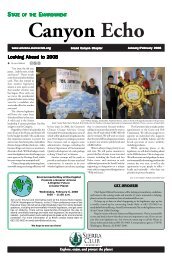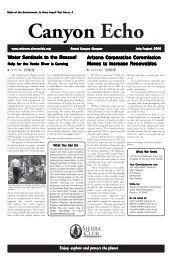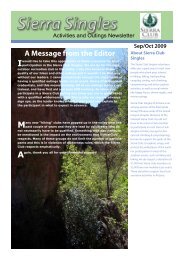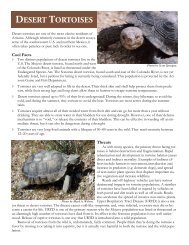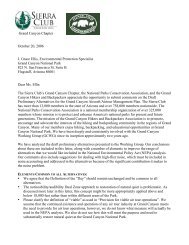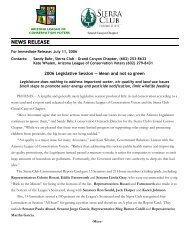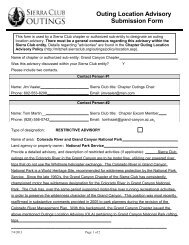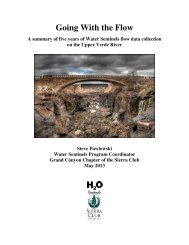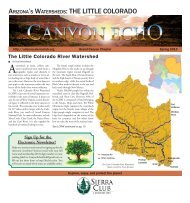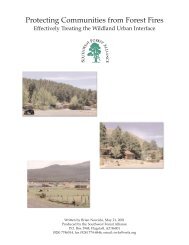Summer 2013 Echo (2.4 MB pdf) - Arizona Sierra Club
Summer 2013 Echo (2.4 MB pdf) - Arizona Sierra Club
Summer 2013 Echo (2.4 MB pdf) - Arizona Sierra Club
You also want an ePaper? Increase the reach of your titles
YUMPU automatically turns print PDFs into web optimized ePapers that Google loves.
<strong>Arizona</strong>’s Watersheds: THE VERDE, GILA, and SALThttp://arizona.sierraclub.org Grand Canyon Chapter <strong>Summer</strong> <strong>2013</strong>Water Sentinels: Upper Verde ThreatenedBy Gary BeverlyThe Verde Watershed is one of themost significant ecological resourcesin the Southwest. The upper VerdeRiver travels through approximately 37miles of this watershed from the river’s headwatersnear Paulden to Clarkdale. This portionof the river supports some of the bestremaining riparian and native fish habitat in<strong>Arizona</strong>, so the <strong>Sierra</strong> <strong>Club</strong> Water Sentinelswork hard to protect the upper Verde.The Water Sentinels have measuredwater quality every two months since 2007at seven points along the upper and middleVerde. The “State of the Verde” report analyzesthe water quality in detail, but thebottom line is that the Verde water qualityis pretty good and easily meets the CleanWater Act standards for body contact, withoccasional exceptions for high E. coli in themiddle Verde.On the upper Verde, Water Sentinelshave measured flow monthly since 2007.The complete results are detailed in the <strong>Sierra</strong><strong>Club</strong> Water Sentinels report “Going WithThe Flow,” released last month. Both reportscan be downloaded from http://arizona.sierraclub.org/conservation/water/index.asp.The flow results portend trouble for theupper 25 miles of the river. The monthlyaverage flow at the U.S. Geological Survey’sPaulden gage (mile 9.8) has been less thanthe long-term average for the last five years.At Perkinsville Bridge, 15 miles downstreamfrom the Paulden gage, summer base flow isonly nine cubic feet per second (cfs). In only15 miles, more than half of the base flowdisappears due to a combination of factors,including evapotranspiration and infiltra-See Verde continued on pg. 12.SeligmanPrescottWickenburgPhoenixSedonaPaysonGlobeAlpineSign Up for theElectronic Newsletter!Help save resources and money by signing up for theelectronic newsletter! Send an email with your fullname and membership ID (8-digit number on yourmailing label) to Canyon<strong>Echo</strong>ESub@gmail.com orfill out the short form at http://bit.ly/e-echo. Youwill receive an email when issues are available online.InterstatesTributariesThe Verde, Gila, and Salt watersheds.Maps created by Scott Sprague.Explore, enjoy, and protect the planetAjoFlorenceSafford
2 <strong>Sierra</strong> <strong>Club</strong> Grand Canyon ChapterCanyon <strong>Echo</strong><strong>Summer</strong> <strong>2013</strong>Vol. 49 No. 3Canyon <strong>Echo</strong> © <strong>2013</strong>. Canyon <strong>Echo</strong> (ISSN 0164-7024) is published quarterly for <strong>Sierra</strong> <strong>Club</strong> membersby the <strong>Sierra</strong> <strong>Club</strong> Grand Canyon Chapter,202 E. McDowell Rd., Ste. 277, Phoenix, AZ85004. Phone: 602-253-8633, Fax: 602-258-6533.Printed at Valley Newspapers.Front page banner designed by Erika Gronek.Printed on 100% recycled paper with soy ink.EDITOR: Tiffany Sprague602-253-9140, tiffany.sprague@sierraclub.orgDEDICATED VOLUNTEERSOutings Editor: Jerry Nelson602-279-4668, peakbagger2@gmail.comMailing Organizers: Don Begalke, Jerry NelsonPublications Committee: Priscilla Benbrook,Jon Findley, Kurt Florman, Chris Gehlker,Tricia Gerrodette, Renée Guillory,Tyler Kokjohn, Jerry Nelson,Carole Piszczek-Sheffield, Mike SmithPublications Chair: Keith Bagwell520-623-0269, kbagwell744@gmail.comWebmaster: John Sheffieldjsheffield40@gmail.comSUBSCRIPTIONS: Annual dues to the <strong>Sierra</strong> <strong>Club</strong> are$39 (including $1 for Canyon <strong>Echo</strong>). Subscription rate fornon-members is $10. Send check payable to <strong>Sierra</strong> <strong>Club</strong> -Canyon <strong>Echo</strong>, 202 E. McDowell Rd., Ste. 277, Phoenix,AZ 85004.ADVERTISING: Advertising is sold on a first-come,space-available basis. The editor reserves the right to refuseany advertisements, and inclusion of advertisements doesnot imply endorsement by the <strong>Sierra</strong> <strong>Club</strong>. All interactionsbetween advertisers and consumers are solely the responsibilitiesof those parties.SUBMISSIONS: Send electronic or hard copies to theeditor (include a self-addressed stamped envelope forreturn of hard copies). Indicate copyright or CreativeCommons preference. We are not responsible for lost ordamaged items. Writer’s guidelines can be obtained bycontacting the editor. All rights to publication of articlesin this issue are reserved. The deadline is the first day of themonth preceding the issue. Opinions expressed in Canyon<strong>Echo</strong> are those of the contributors and do not necessarilyreflect the official views or policies of the <strong>Sierra</strong> <strong>Club</strong>.POSTMASTER: Send address changes and postagedue to <strong>Sierra</strong> <strong>Club</strong> Member Services, c/o Canyon <strong>Echo</strong>,P.O. Box 421041, Palm Coast, FL 32142-6417. Periodicalspostage paid at Phoenix, AZ.<strong>Arizona</strong> Chapter Action DirectoryChapter DirectorSandy Bahr 602-253-8633 sandy.bahr@sierraclub.orgChapter CoordinatorTiffany Sprague 602-253-9140 tiffany.sprague@sierraclub.orgGrand Canyon Conservation Program CoordinatorAlicyn Gitlin 928-774-6514 alicyn.gitlin@sierraclub.orgBorder Conservation Program Coordinator and Coal to Clean EnergyDan Millis 520-620-6401 dan.millis@sierraclub.orgWater Sentinels Program CoordinatorSteve Pawlowski 602-254-9330 steve.pawlowski@sierraclub.orgGRANDCANYONCHAPTER(xc) <strong>2013</strong> ChapterExecutive Committee(Ex-Com) membersCHAPTER OFFICES & COMMITTEE CHAIRS<strong>2013</strong> Group Voting Representatives to Chapter Ex-Com (see pp. 12–13 for contact information):Palo Verde: Mike Brady Saguaro: Jim WilkeyPlateau: Dick Hingson Sedona/Verde Valley: Carole Piszczek-SheffieldRincon: Randy Serraglio Yavapai: Gary Beverlyhttp://arizona.sierraclub.orgChapter AnnouncementsFlagstaffSEDONA/ VERDEVALLEYPrescott YAVAPAIPhoenixPALO VERDEJUL 8, AUG 12, SEP 9 (MON) 7 p.m. Political Committee meetings. Do you love <strong>Arizona</strong> but feel left out by the political directionthe state is taking? Your voice for reason and recognition of the role of conservation can be even louder if you participate in ourPolitical Committee! For more information, contact Elna Otter at 520-212-9736 or elna.otter@gmail.com.JUL 23 and SEP 24 (TUE) 6 p.m. Energy Committee gatherings. Discussions, programs, and field trips encompass various energyactivities, including renewable energy and energy efficiency campaigns nationally and locally. Everyone is invited to participate, nomatter how much or little you know about energy issues. Specific time and location will be announced online or via email. To beadded to our list or to get more information, please contact Jon Findley at 480-756-2916 or energy@grandcanyon.sierraclub.org.AUG 7 (WED) 6 p.m. Publications Committee meeting. Have an idea? Help plan future issues of Canyon <strong>Echo</strong>! Contact KeithBagwell at 520-623-0269 or kbagwell744@gmail.com or Tiffany Sprague at 602-253-9140 or tiffany.sprague@sierraclub.org. Allmeetings conducted via Skype/phone.AUG 14 (WED) 6:30 p.m. Wildlife Activist Group meeting. Are you interested in learning more about <strong>Arizona</strong>’s wildlife and inworking for species’ protection? Join us to learn more about what’s happening with <strong>Arizona</strong>’s wildlife, upcoming projects andopportunities, and how you can get involved. For more information, contact Dale Volz at 480-892-5102 or dvolz@earthlink.net.SEP 1 (SUN) Copy deadline for Fall <strong>2013</strong> Canyon <strong>Echo</strong>. Theme of “<strong>Arizona</strong>’s Watersheds: The San Pedro and Santa Cruz.” Articles,art, photographs, poetry, and brief epiphanies are welcome. Contact the editor before submitting at 602-253-9140 or tiffany.sprague@sierraclub.org to discuss word count, photos to include, licensing, issue topics, and to request submission guidelines.SEP 25 (WED) 1–5 p.m. (stop by anytime) Canyon <strong>Echo</strong> Mailing Party. Volunteers save the Chapter hundreds of dollars bypreparing Canyon <strong>Echo</strong> for mailing. Thank you! The job is easy to learn, and we all have a great time. Any amount of time that you’reavailable is appreciated. Contact Jerry Nelson at 602-279-4668 or peakbagger2@gmail.com for details.OCT 5–6 (SAT–SUN) Chapter Conservation (SAT) and Executive Committee (SUN) meetings. <strong>Club</strong> leaders meet to considermatters related to statewide conservation efforts, share experiences across groups, and coordinate strategy to align ourChapter mission and goals with that of national <strong>Sierra</strong> <strong>Club</strong>. The meetings will be located in Flagstaff. For more information,contact Don Steuter at 602-956-5057 or dsteuter@hotmail.com or Ken Langton at 520-749-3829 or kplangton@msn.com.TucsonPLATEAUSAGUARORINCONChairperson: Ken Langton (xc) 520-749-3829 kplangton@msn.comVice-Chair/Political: Elna Otter (xc) 520-212-9736 elna.otter@gmail.comSecretary: Carole Piszczek-Sheffield 928-204-1517 cpiszczek@msn.comTreasurer: David McCaleb (xc) 602-840-7655 davidCmccaleb@gmail.comFundraising: Jenny Roberts (xc) 480-488-2256 azjen@hotmail.comConservation: Don Steuter (xc) 602-956-5057 dsteuter@hotmail.comOutings: Jim Vaaler (xc) 602-553-8208 jimvaaler@msn.comMembership: Mike Brady 480-250-4054 pvg.chair@gmail.comNatalie Lucas 928-600-7844 nrlucas@email.arizona.eduEx-Com (At-Large): Keith Bagwell (xc) 520-623-0269 kbagwell744@gmail.comBev Full (xc) 480-221-2554 bfull@cox.netTom Martin (xc)tomhazel@grand-canyon.az.us
<strong>Summer</strong> <strong>2013</strong> Canyon <strong>Echo</strong> 3Grand Canyon Chapter – What’s Going On?I WANT YOU!You Are The <strong>Sierra</strong> <strong>Club</strong>Oppose the South Mountain Freeway!Submit comments by July 24Volunteer leadership positions within theGrand Canyon Chapter are an ideal wayto deepen your involvement in the issuesimportant to you. Your club needs committedpeople who will give their timeand energy to further its mission to explore,enjoy, and protect the planet.Become a candidate to serve on yourgroup or chapter executive committee! Noexperience is necessary. If you want to helpcreate a vision, make policy, execute plans toprotect and preserve our environment, and havefun while doing it, please nominate yourself. If youknow of another good person, let us know.If you would like to learn more about what would be involved, please contactone of the following leaders: Nominations Chair Dale Volz at 480-892-5102 ordvolz@earthlink.net, Chapter Chair Ken Langton at 520-749-3829 or kplangton@msn.com, or your group chair (see pp. 12–13).Guidelines for chapter and group executive committee elections:1) To be listed on the ballot, candidates must submit their names and membershipnumbers. If you aren’t sure what your membership number is, see your Canyon<strong>Echo</strong> label or contact the chapter office at 602-253-9140. Be sure to include contactinformation along with your submission.2) Submit a candidate statement (recommended but not required), indicating thechapter or group executive committee for which you are running to the NominationsCommittee at dvolz@earthlink.net by no later than August 15, <strong>2013</strong>. Candidatestatements are limited to 200 words and must be submitted by email. You will receiveacknowledgement within a few days of submission. (Because much of the executivecommittee’s business is done by email, candidates must have email capability.)The official ballot will appear in the Fall <strong>2013</strong> Canyon <strong>Echo</strong>. So, go ahead, nominateyourself or someone else you think would be a good leader.Thank you for stepping forward!Sign at South Mountain Park. Photo courtesy of Erica MuchucaThe South Mountain Freeway is a proposed 22–24 mile, eight-lane freeway thatwould extend the southern portion of Loop 202 to connect with Interstate 10 west ofPhoenix. The project would cut through a portion of South Mountain Park, the largestcity park in the U.S.; destroy habitat and cut off wildlife movement corridors; worsenregional air quality and exacerbate related health issues; disrupt sacred places; encouragelong commutes; and much more. It would also continue the <strong>Arizona</strong> Departmentof Transportation’s (ADOT) short-term vision rather than focus on long-term transportationsolutions.ADOT is seeking public comments on the proposed freeway. Please participate ina meeting and/or submit written comments. Comments are due by July 24.You can learn more about the freeway and upcoming meetings and submit commentsonline at http://bit.ly/SouthMountainAction. For additional information,please contact Sandy Bahr at 602-253-8633 or sandy.bahr@sierraclub.org.2 Chapter Announcements4 Happy Trails, Rob and Joni!5 Thank You!6 Salt RiverShowcase Your Photos at the Smithsonian Institute!Enter the Nationwide Wilderness Photography ContestNext year is the 50 th anniversary of passage of the Wilderness Act. A coalition of partners, including <strong>Sierra</strong> <strong>Club</strong>, isplanning celebrations across the country.A major event next year will be a display of wilderness photos at the Smithsonian Institute in Washington, D.C. Aphotography contest is being held to determine what images will be displayed. It would be wonderful if photos from some of<strong>Arizona</strong>’s 90 wilderness areas are in that display, and who better to submit them than photographers from <strong>Arizona</strong>!Photos from amateurs, students, and professionals are encouraged. There are four categories: scenic landscape, wildlife,people in wilderness, and most inspirational moment. The last date to submit entries is September 3, <strong>2013</strong>.Learn details of the contest at http://www.naturesbestphotography.com/wilderness.php.Submissions can be made online or by mail.7 Gila River8 Youth in Nature10 Good Jobs Green Jobs11 In Memory12 Group Happenings14 Hikes and Outings16 Service Outingshttp://arizona.sierraclub.org
4 <strong>Sierra</strong> <strong>Club</strong> Grand Canyon ChapterHappy Trails to Our Good FriendsRob Smith and Joni BoshLongtime <strong>Sierra</strong> <strong>Club</strong> Southwest Staff and Senior Organizing Manager Rob Smith andformer national board director and treasurer and volunteer at the local and chapter level JoniBosh are heading to the Northwest to start a new adventure and to continue their careers toprotect the planet. Rob has taken a position with National Parks Conservation Associationin Seattle.We are grateful to both of them for their decades of work to protect Grand Canyon andthe Grand Canyon State. Joni helped form the original <strong>Arizona</strong> Wilderness Coalition, whichsaw millions of acres of wilderness protected in <strong>Arizona</strong>. She also represented <strong>Sierra</strong> <strong>Club</strong> as avolunteer lobbyist and led the successful effort to defeat a bad regulatory takings measure viaa citizen referendum. Joni stepped up twice to serve on the national board of directors, all thewhile staying active at the local level. Rob worked tirelessly on public lands issues throughoutthe Southwest and, more recently, supervised organizing work around the Beyond CoalCampaign. He helped <strong>Arizona</strong> get strong wilderness bills, protective measures for GrandCanyon, and five Bureau of Land Management national monuments. Rob has been a leaderon following the advice of Theodore Roosevelt relative to Grand Canyon:“In the Grand Canyon, <strong>Arizona</strong> has a natural wonder which is in kind absolutely unparalleledthroughout the rest of the world. I want to ask you to keep this great wonderof nature as it now is.”Joni Bosh and Rob Smith at their going-away party. Photo by Sandy Bahr.Before his departure on June 3 rd , Rob received the <strong>Sierra</strong> <strong>Club</strong>’s Larry Mehlhaff Awardfor Excellence along with two of his national colleagues. Joni had previously received the national<strong>Sierra</strong> <strong>Club</strong>’s Special Achievement Award for her work to defeat the takings measure.We recognize the advocacy and leadership of both Rob and Joni and appreciate theiryears of being great friends, mentors, and strong advocates for protecting wild placesthroughout the state and the Southwest. We will miss them here but wish them well andlook forward to hearing about the great work they do in the Northwest.–written by Sandy Bahr, Chapter DirectorCast of CharactersMeet Birgit LoewensteinBirgit Loewenstein.Photo courtesy of Birgit Loewenstein.We could solve some seriousenergy problems if we could just tapinto some of the energy Birgit exudes.The petite Sedona resident isa powerhouse of focused dynamism.Growing up in Bavaria, Birgit hikedtrails in the Alps, learning early on thepower of solitude in nature and developinga commitment to preservingthe environment.“Hiking in the mountains wasmy entertainment. I backpackedfrom hut to hut without worry,” reminiscedBirgit. “My stress relief – regardlessof its origin – is always foundin Nature.”Birgit’s latest trek was a tendayhike into Grand Canyon viathe South Kaibab Trail to PhantomRanch, then cross country tothe Nankoweap Trail, ending at theNorth Rim, covering 60 miles and atotal 16,000-foot elevation change.“When I came to the United States, I encountered a different world. I remember takingthe ferry to Martha’s Vineyard and seeing dozens of plastic yogurt cups bobbing in the water.I was so disgusted that I started making my own yogurt, which I still do today.”Having lived in areas where water is abundant has given Birgit an appreciation for thevery different American Southwest climate. “It is a mistake to think that environmental programsare one size fits all. We live in a desert. We simply do not have the natural resources tosupport massive development.”Birgit became involved in environmental issues while living on Cape Cod, helping witha citizen’s movement to preserve open space by creating a Land Bank. When she moved toSedona, she sought to do something similar with Bella Terra, a proposed development alongOak Creek that would have included building a wastewater treatment system with leachfields that could drain into the creek. People who lived in the area feared contamination ofthe water table and the creek. Birgit joined the Red Rock Rural Community Association(RRRCA) to fight the development.When Red Rock State Park was threatened with closure in 2010, Benefactors of RedRock State Park agreed to Birgit’s proposal to keep it operating. “I was most concerned aboutthe park’s Environmental Education programs, particularly its school program, the only oneof its kind in Northern <strong>Arizona</strong>. It is important to reach youth, to introduce them to thenatural world. <strong>Sierra</strong> <strong>Club</strong>’s Save the Parks program inspired us. I was naïve – I thought if Igot a busload of people to talk to our legislators and extol the value of the parks, we couldchange their minds about sweeping funds from the parks. That didn’t work – but we provedthat citizens love their parks and are willing to work hard for them.” Because of the Benefactors’and volunteers’ tireless work, Red Rock State Park has remained open, offering its fullenvironmental education program.Her current project? Helping Keep Sedona Beautiful get a National Scenic Area designationfor the spectacular landscape around Sedona. Her next hike? “Probably into a canyon – Ilove the interface where desert and water meet!”http://arizona.sierraclub.org
<strong>Summer</strong> <strong>2013</strong> Canyon <strong>Echo</strong> 5The Morning Stars SingTogether ($500+)Donald BegalkeKenneth P. LangtonJeffrey SchlegelMake the Mountains Glad($100–499)Keith BagwellSusanna BeattyConstance M BeaupreT & R BerringerGary & Molly BeverlyBrian BlanchardLoring CannonEric CoonsGerald D. CoxMr. & Mrs. Rudy DankwortBarbara & Don DeMuthLynn DeMuthRoy & Frances EmrickJohn & Pam EvansSharon FairchildMr. & Mrs. Dwight FinkelTim Flood, MDJoe FlynnJohn M. FranklinCraig FriesnerCatharine GarmanyWilliam R. GillEd GogekPaul GolabJoseph R. HellerJoy & Dave Herr-CardilloTim HoganDavid & Barbara KellySarah KingMichael L. KottkeB. R. & W. R. LoewensteinRobert MawkYolanda Mc AuliffeDavid McCalebBlair McLaughlinCary W. MeisterJanet E. MooreJanice E. MyersSateesh J. NabarJames NafzigerJerry NelsonTim OBrienCarole Piszczek-SheffieldLinda & J. Michael PowersJoan PriceMichael QuinlanRobert ReismanSally RingsJenny RobertsKathy RoedigerJim RutherfordCarol SalvatiNancy SantoriBeverly SassKaren L. SchroederAlice & Karl StambaughDon SteuterF. Stoller & W. GrabeWilliam ThorntonJ. Tillotson & E. R. HolmesTom TimmerPatricia & Richard VivianWalt WictorRobert WistMr. & Mrs. Raymond WittcoffTom & Sally WoodsKeep Close to Nature’s Heart($50–99)Linda AllenStuart & Cindy AltRobert AndroffDr. & Mrs. Robert D. BerenLT Col D. R. BergJeff & Keesha BestBettina BickelDoug BlandThomas BrennanMrs Beryl CatersonDavid CathellDavid & Lisa CherneyCathy CohnM. A. CookDennis & Sevren CoonMark CoryellDevin CruiseTam DeWittJohn DotyLinda Gale DrewGordon FergusonEkkehard & Anneliese FischerVicky & Mark FosterKathy & Roger GarrettPaul R. Gordon & Eve ShapiroH. GroemerMr. & Mrs. Thomas HagerNadine HarrisMichael HarrisonBarbara H. HoladayRaena HonanGary & Yvonne HuckleberryMargaret HuntingtonDavid JessupBrenda JobeThank you to Edwards Mother EarthFoundation for its generous support ofour energy efficiency efforts in <strong>Arizona</strong>.Thank You to Our Donors!J. Kay Johnson & W. TowlerRuth G. KatzEva KilbourneMarianne KlugheitTyler KokjohnSusan KunzDianne LangmadeAngela LefevreJoanne LewisJonathan LloydMr. & Mrs. Ivo LucchittaFelicia & Warren MayGary McCormickHarry MitchellScott MittelsteadtJohn NorrisS. Painter & K. WetzelEllen ReedAnne ReevesGina RichmanBarrie RyanBetty SadowskyD. SammataroRobert SchefflerCharles SchulzChris SmithDonald SmokerEthel A. StaleyMichael TamarackStephen & Susan ThompsonJack & Joy TuberLois TyaackAnita ValdezKathy VegaHenry WareDuane WeiszDonna WillettHitched to Everything Else inthe Universe ($1–49)Steve ArthurKatharine BarringtonJean BickelJohn & Linda BlackwellRosella R BonhamRodney BoorseDonna & Robert GilbyJoan S. BriggsCarolynn BryanJan BuckwalterRobert D. Cable, Jr.Maria CadaxaDavid CardinaliJohn ChatfieldDavid & Roberta ChorltonLee ChutkowJean ClarkRonald CohenDwight W. ConnelyTom CuevasDennis R. DavisAugusta DavisNorman & Shirley DavisMargaret Day & John HertzMr. & Mrs. Clifford K. Demayohttp://arizona.sierraclub.orgJeanne DevineW. David & Virginia DotsonAlicia DoughertySheryl EatonLorraine EwbankTed FaroneGeorge FerencTeresa FinleyJames FishgoldSarah FoxDeborah & Steve FranksBarry & Madeline FriedmanRobert FrostErika GarciaSara GibsonNanette GloverThomas E. GoffMark Hayduke GrenardRita GuidiRenée GuilloryDita HagenRobert R. HallJoan & G. J. HamburgerViktoria HawkWayne HaysMr. & Mrs. Steve HertzfeldAlfred HoegerDavid HoernerBetty & Earle HoytJane KentnerJules KetchamMichael KnappRivko KnoxAlexander KouvelLynn L. KrauseJohn LacostDavid & Lisa LanningJohn LippertKaren LloydMalcolm MacEwenJudith MaedaStig MagnusDaniel G. MartinThank you to those who donatedto our Water Sentinels program:Robert AlleySandy BahrGary BeverlyDan CampbellDoris & Richard CellariusBarbara Kojis & Norman QuinnBarbara RatomskaMichelle WaltersThank you to Julie Kwatra for donating in honor of CherylCook to celebrate the new “environmentalist” Pope Francis.Sandra MaxwellSharon McDonough-MeansNate McMullenMatt McWenieJanos MolnarSue MoodyD. W. Mount & J. D. HallCarroll MunzMarita NickersonJoan NorenLee OlerWalter OlmstedSimone OssipovJohn D. Palmer, MDRobert & Jeanne PetersonHannah Phipps-YonasPeter RaganAlejandro RangelFritzi RedgraveJohn ReevesMcDonald RobinsonGena RowdenJim ScheefGail SchuesslerFred ShaftNancy SieferTom & Jane SkinnerJanet & Thomas SlivaRita SmallingDebbie StinsonCarol TepperPatricia TheisenGerald UfnalDeborah VathSara J. VittalAlynne WellsJudy Kathryn WhitehouseHal & Cathy WilliamsKarl WilsonMelvin WrightFrank ZimmerGabriel P. ZinsliThe Grand Canyon Chapter is also thankful for the generoussupport from those who chose to remain anonymous.
6 <strong>Sierra</strong> <strong>Club</strong> Grand Canyon ChapterRio Salado: A Riparian Oasis in the Heart of Downtown PhoenixBy Steve PawlowskiThe Rio Salado Habitat RestorationArea is an urban watershed renewal projectthat runs through the heart of the Phoenixmetropolitan area. This five-mile section ofthe Salt River channel extends from 28 thStreet on the east to 19 th Avenue on the west,just a few miles south of downtown Phoenix.It encompasses 595 acres of restoredriparian habitat in a state that has lost morethan 90% of its riparian habitats.For nearly a century, the Salt River channelin Phoenix was a dry bed resulting fromupstream dams and surface water diversionsthat began in the early 1900s. In 1993, theCity of Phoenix initiated a study to design arestoration project to transform the blighted,dry river bed that was lined with waste tiredumps, construction debris, and sand-andgraveloperations into a beautiful linear parkof ponds, riparian and wetland habitats, terraces,and miles of hiking, biking, and equestriantrails. Construction of the Rio Saladobegan in Spring 2000 and was completed inNovember 2005. Approximately 1,185 tonsof waste tires and 138,572 cubic yards of debriswere removed, and more than 76,000native plants were planted.The Rio Salado is a bird-watcher’s paradise.More than 200 species of birds havebeen identified in the restorationarea, which alsoprovides habitat for smallmammals, reptiles, andamphibians. There are 88acres of mesquite bosquehabitat, 14 acres of cottonwood/willowhabitat,193 acres of lower Sonoranhabitat with paloverde and mesquite trees,39 acres of wetland marsh,57 acres of saltbush, and31 acres of aquatic habitat.These habitat features provideexceptional opportunitiesfor birding, wildlifeviewing, nature photography,recreation, and environmentaleducation.The essential element for any riparianhabitat in a desert is water. The sourceof water for the Rio Salado is a system offive wells that pump groundwater from theaquifer under the Salt River channel into therestoration area. Approximately 3.5 milliongallons of groundwater are pumped eachday into water features and are distributedthrough the irrigation system to sustain theA volunteer helps plant native species in the Rio Salado Habitat Restoration Area.Photo by Mark Coryell.Get Involved!wetland and riparian plants. Also, there are22 storm drains that channel storm waterinto the channel when it rains in the valley(unfortunately, it channelstrash and litter into the riverbed, too).That’s one of the reasonswhy the Rio Salado restorationarea is a work-in-progress andcan always use a helping hand.The <strong>Arizona</strong> Water Sentinelshave worked with the Cityof Phoenix Parks and RecreationDepartment to maintainand enhance the Rio Saladothrough our “Weed & Clean”program. Once a month, <strong>Sierra</strong><strong>Club</strong> volunteers gather toremove buffelgrass and to pickup trash and litter. Sometimes,we do revegetation projects,planting native plants at thegateway trailheads leading intothe restoration area.Steve is the Water Sentinels Program Coordinator.If you want to discover the beautiful Rio Salado while doing some “hands-on” conservationwork, join the Water Sentinels at our next Rio Salado Weed & Clean! ContactSteve Pawlowski at 602-254-9330 or steve.pawlowski@sierraclub.org.Livestock Grazing Threatens Upper Salt RiverBy Jim VaalerThe Salt River aboveState Route 288 is wild andbeautiful. It has one existingwilderness area, the Salt RiverCanyon Wilderness, and oneInventoried Roadless Area(IRA), the Picacho IRA. Thiswhole Forest Service sectionof the river is eligible for Wildand Scenic river status.A major threat to this partof the river comes in the formof a grazing proposal entitled“Salt River Allotment AnalysisDraft Environmental ImpactStatement.” If adopted,this proposal would set a badprecedent for managing largesections of wild and sensitiveThe Upper Salt River. Photo by Jim Vaaler.lands as it encompasses noless than six grazing allotmentscovering more than275,000 acres of publicland. The affected grazingallotments are the Chrysotile,Haystack Butte, Sedow,Dagger, Hicks-PikesPeak, and Poison Springs.The river corridorhas been closed to grazingfor almost 10 years,and the result has been asignificant improvementin the quality of the habitat,including re-growthof riparian vegetation,cow-pie-free beaches, andan improvement in waterquality. The new proposal will allow cattlegrazing and access all along and in the river.The proposal calls for a huge increase in thenumber of cattle along with a huge increasein the number of grazing structures to supportthem.This grazing proposal has no basis insound science or in having a healthy riveror riparian areas. Its premise is the repeatedlydisproved idea that cattle can be usedas a tool to improve ecological conditions onour public land. The proposal itself seemsto have been drafted primarily by the livestockindustry, so perhaps it is no surprise itviews grazing so favorably. That being said,it is the job of the Forest Service to look atthe best available science and to analyze theSee Salt River continued on pg. 10.http://arizona.sierraclub.org
<strong>Summer</strong> <strong>2013</strong> Canyon <strong>Echo</strong> 7Dam(n) It: Excising the Gila RiverBy Priscilla BenbrookThe Gila and its tributaries – the SanSimon, San Pedro, and Santa Cruz to thesouth and the San Francisco, Salt, AguaFria, and Hassayampa to the north – onceformed the most important river systemin the Southwest. Beginning at an altitudeof 5,551 feet near the confluence of NewMexico’s East and West Fork rivers, the Gilaends in the Colorado River near Yuma, 619miles to the west.The early Hohokam grew cotton alongthe Gila in 200–300 A.D. Their canals andwells were thought to sustain some 60,000people, the center of which was Snaketown,near present-day Phoenix. In the 1500s,conquistadors arrived and christened theriver the “Gila,” a word reportedly derivedfrom a Spanish contraction of Hah-quah-saeel,a Yuma word meaning “running waterwhich is salty.”The modern Gila reads like an accountof an oncologist racing to excise cancer – thecancer being unexploited water. The HomesteadAct of 1862 granted 160 acres to anyonewilling to farm the area for five years.All the settlers had to do was add water. By1880 diversion dams built by Mormon settlersat Florence sent nearly the entire riveroff course. Soon the Gila was lined withsmall farms producing a variety of crops,ranging from tomatoes to melons. (Indeed,Phoenix originally held the stupefying monikerof “Pumpkinville.”)It is said that nature provides mechanismsagainst the vanity of human wishes. InFebruary of 1904, the Gila flooded and dischargedinto the swollen Colorado, carryingwith it an uprooted oak tree. The tree compromiseda control gate above Yuma, causingwater to surge into the long-dead AlamoRiver. Revitalized, the Alamo found its wayto the Salton Sink and recreated the SaltonSea. Settlers were unfazed by the Gila’s complaints.Demand for water increased withthe introduction of water-intensive Egyptiancotton for use in World War I. Water wasdiverted into canals, leaving the Gila all butdead west of Gila Bend.Developers continued excising.Coolidge Dam – the first major barrier onthe Gila – was completed in 1928. (Thedam was opposed by San Carlos Apache,but a “compromise” was made. Today tribalburial grounds and Geronimo’s camp canbe “visited” at the bottom of the reservoir.)Coolidge Dam was a primary factor in slowingthe flow of the Gila near Phoenix. In1983, heavy rains required water releasesfrom Coolidge. Operators discovered thatthe gates had been rusted shut for more than10 years. It was named the most dangerousdam in the U.S. and continues deteriorating.Threats to the Gila and its 40 threatenedor endangered species, including theGila topminnow, Chiricahua leopard frog,southwestern willow flycatcher, Mexicangray wolf, and <strong>Arizona</strong> cliffrose continue.Diversions to supply water for the 5,000,000people in its basin remain primary threats(e.g,, a typical golf course uses between500,000 and 1,000,000 gallons per day…teed off yet?).Edward Abbey noted that “growth forits own sake is the ideology of the cancercell.” Cut it out!Priscilla is a freelance science writer with degrees inConservation Biology and English from ASU.Why Should We Care about the Motorola Superfund Site?By Mackenzie Kong-Sivert and Kiera MessingTwenty years ago, Motorola’s 52 ndStreet semiconductor plant contaminatedPhoenix’s groundwater supply with toxicchemicals as far north as Palm Lane, as farsouth as Buckeye Road, and as far west as7 th Avenue. That was 20 years ago. TheEnvironmental Protection Agency (EPA)put it on its National Priorities List andensured an effort to remove as much ofthe chemical waste as possible from thegroundwater. Even though this process isslow and the groundwater will likely not beused until about 25 years from now. Why,then, should we worry about the effects ofsomething that happened so long ago? Weshould care because the contamination ofgroundwater is only the beginning.The toxic chemicals in this water can andhave seeped into the soil that many residentsof the area use to grow gardens, many ofwhich contain plants that the residentseat. Additionally, by a process called vaporintrusion, contaminants in the groundwaterrise up through the soil and into the air,which can be especially dangerous if thevapors rise through the floors of enclosedspaces such as homes, which trap the toxicvapors inside.The EPA conducted a study in 2006with staggering results showing us thatwe cannot ignore this problem. First,concentrations in Phoenix of several toxicchemicals were found to be higher thanconcentrations in 75% of urban areas inthe U.S. In addition, the air was found tocontain elevated concentrations of variouschemicals at levels well over the cancerbenchmark. Although there is some level ofuncertainty in everything in science, it seemsvery likely that the primary source of thesecontaminants is the Superfund Site.Another chemical on the site istrichloroethylene (TCE). Upon exposure,TCE is carried through the bloodstream andaccumulates in fat and other tissues. TCEhas been linked to reduced fertility, immunerelatedproblems, brain damage, and variousforms of cancer. None of this information isnews; this has been happening for decades,but many residents of the site neitherknow nor care much about this site. Theinformation is available for those who searchfor it, but few actually do.About 100 miles from the Motorolasite is another Superfund site, the TucsonInternational Airport area. In 1985, threeyears after the area was declared a Superfundsite, Tucsonans for a Clean Environmentfiled a personal injury lawsuit with over1,600 plaintiffs and went on to win thelargest settlement in a case involvinggroundwater contamination in the entirehistory of the U.S.This is not to say, of course, that therehas been no community involvement onthe Motorola Superfund Site. There havebeen people who are active in trying to dosomething about this site, and they havebeen very dedicated, but there are notenough of them. We ought to take a pagefrom Tucson’s book: having safe water, safeland, and safe air is an important and validconcern.Mackenzie and Kiera are students at Bioscience HighSchool (a science magnet in downtown Phoenix) andcollaborators for awareness of water contamination.Learn More!For up-to-date information aboutcommunity meetings and communityinvolvement efforts for the 52 nd StreetPlant, see http://bit.ly/motorola52.http://arizona.sierraclub.org
<strong>Summer</strong> <strong>2013</strong> Canyon <strong>Echo</strong> 9ICO Gives 8 th Graders First Backpacking Trip in Aravaipa CanyonBy Kyle KacerekNote: The quotes on this page were said by the students during the Aravaipa trip.Five 8 th graders from a Title I schoolhad great stories to tell their parents on EasterSunday, after returning from their firstmulti-day backpacking trip in AravaipaCanyon. The three-day, two-night trip wasled by Inner City Outings(ICO) leaders Kyle Kacerek,Aaron Fisher, and CherylWalling. The experience was designed to beeducational and enlightening, as none of theSafford K-8 Magnet School students hadbeen backpacking before, and most had littleoutdoor experience in general.“We should have stayed the whole week!”The leaders coordinated a “mock-backpack”hike in the Tucson Mountains twoweeks before the actual trip, during whichthey sized backpacks for the students, loadedthem up with gear,and hiked the DavidYetman trail. The studentslearned manyskills and information critical to backpacking,including appropriate gear and clothing,Leave No Trace principles, and how toset up a tent. By the end of this mock hike,the students had a much better idea of whatto expect on their upcoming adventure.“My parents never let me eat chocolate thisearly in the morning.”The group departed for the west entranceof Aravaipa Canyon early on March28. The 11-mile canyon contains one of theonly perennial streams in Southern <strong>Arizona</strong>,forming a lush, wildlife-filled riparian zone.There is little elevation gain on the hike,making it a wonderful first-timers backpackinglocation. The eight backpackershiked several hours into the stunning canyon,frequently crossing the mid-calf-deepstream. About four miles into the canyon,“I like it out here, but that pool was just cold.”they set up camp on a sandy bench nestledup against the southern canyon wall – thesite they would call home for the next twonights. The following day included sidecanyon exploration and a lot of swimming,which was perfect in the 75° sunny weather.“I could live down here.”“If there’s one word to describe this place...it’s pretty hard to pick one word.”The students were particularly fond ofexploring Hells Half Acre Canyon. Ascendingthis serene side canyon involved navigatingmassive sparkling pieces of dark redporphyry rock and clear cascading pools.The young teens had a blastsubmerging themselves andsplashing around in a largenatural granite-lined pool. Following theafternoon dip, some of the group took apeaceful nap in the concave bed-like recessionsatop the water-worn boulders thatcoated the canyon floor. Before returning tocamp for dinner, the group collected sticksthat were trapped by a fissure in the canyondrainage, likely as a consequence of a priorflood. This was the perfect context for thestudents to apply their new knowledge of the“four Ds of responsibly collecting firewood”(dead, down, distant,and diameter).Other activitiesand learning experienceson the trip included backpackingstoveuse, backcountry cooking, hangingfood at night, backcountry hygiene, creekwater retrieval and purification, properdisposal of human waste, other Leave NoTrace teachable moments, orienteering, selfreflection journaling, campfire building andresponsible use, creek games, and a desertsurvival group activity around the campfire.On March 30, the group packed up“I’ve finally climbed something I’ve neverclimbed before.”and hiked out of the strange green canyonin the desert to return home to reunite withtheir families in Tucson in time for Easter.Other quotes heard:Kyle is an ICO leader.Student A: “We’re close to camp.”Student B: “Yep, there’s Karl.” (They namedthe cave near their camp “Karl.”)Student: “I wish we could stay ’til Sunday.”Leader: “It’s Easter Sunday....”Student: “Easter came early!”http://arizona.sierraclub.orgYouth enjoy a backpacking adventure in Aravaipa Canyon. Photo by Kyle Kacerek.Oak Flat Land Exchange UpdateBy Don SteuterThe U.S. House Natural ResourcesCommittee on May 15 narrowly approvedResolution Copper Mining’s (RCM) latestbill to trade away 2,400 acres of TontoNational Forest land in and around OakFlat Campground adjacent to Apache Leapnear the town of Superior. The 7,000-footdeepore deposit is reportedly the largest inthe lower 48 states, and extracting it in themanner proposed by RCM would result ina subsidence zone comparable to the size ofmeteor crater north of Flagstaff.Introduced by Reps. Paul Gosar andAnn Kirkpatrick, the derisively nicknamed<strong>Arizona</strong> Sandbag and Land Indigestion Act(HR 687) is the 12 th such attempt at a congressionallyapproved mining project. It allowsexchange without first undergoing NationalEnvironmental Policy Act analysis todetermine what effects the project will haveon such things as nearby Gaan (Devil’s) Canyon,regional groundwater, and air quality innearby Class I wilderness areas. Notably, anamendment introduced by Rep. Gosar removedlanguage that ostensibly would havehelped Superior purchase the town cemeteryand airport from the Forest Service as thelands they are located on have always beenin federal ownership. The amendment wasretribution for the Town Council’s recentrejection of its working agreement with themine owners. Without question, HR 687 isthe worst bill yet introduced by RCM andneeds to be relegated to the junk heap alongwith the previous bills.Meanwhile, opposition to the minecontinues to grow. Residents of Queen Valleyvoted to oppose the mine over concernsabout lowering groundwater tables and theproposed waste rock dump on 14 squaremiles of State Trust Land at their front doornear Florence Junction. All local and manynational Native American tribes now opposethe mine, as do more than two dozen environmentaland outdoor organizations.For more information on the destructiveimpacts of this mine and how to contactyour representative in Washington, visit the<strong>Arizona</strong> Mining Reform Coalition websiteat http://www.azminingreform.org and ourchapter website. The Grand Canyon Chapteris a founding member of the Coalition.Don is the Chapter Conservation Chair.
10 <strong>Sierra</strong> <strong>Club</strong> Grand Canyon ChapterSky Island EncountersThe <strong>2013</strong> Good Jobs Green Jobs Conference: A Brief ReviewBy Ronald RoedelOnce there was a turkey struttingdown the path, and oncea golden snakestretching long to soak up warmth;once a deerstopped suddenly in timewhen we were in that moment;and once a bearpassed along the far edgeof a streamon his way to the saddle where fernsmake lace of the light.Once a lizardturned to amethyst before usand once the groundswelled with toads that bubbledthrough the dust.A fox onceleapt out of the moonand sat on the road.We saw them all. They did not stay,but turned for whereverthey needed to go,as the ocelot didwho lived hereonce.–David ChorltonSalt River continued from pg. 6.The <strong>2013</strong> Good JobsGreen Jobs Conference(GJGJ) was held in Washington,D.C., from April16–18. I am very grateful tothe Grand Canyon Chapterfor the nomination to attendand to National <strong>Sierra</strong> <strong>Club</strong>for a scholarship to cover myfees.The conference, heldannually since 2008, is sponsoredby the Blue Green Alliance(BGA), a partnershipbetween the <strong>Sierra</strong> <strong>Club</strong>and the United Steelworkersof America (USW) thathopes to build a robust greeneconomy that “preserves oureconomic and environmentalsecurity.” Although thesetwo outcomes have oftenbeen regarded as inherentlycontradictory, the <strong>Sierra</strong><strong>Club</strong> and the USW have recognizedthat they can worktogether through this strategic partnership.Approximately 2,500 people attendedthis convivial and lively conference. Thefirst two days featured a variety of interactiveworkshop sessions; I concentrated onthose related to solar energy and discoveredthe following key points: Solar power effortshave yielded concrete progress withalternatives and thoroughly examine the impactsto the land, river, and area’s plants andanimals. Unfortunately, the Forest Serviceinstead presented a document that promoteslivestock grazing to the detriment of nativespecies.A major wildlife concern is the impactthe cattle will have on the critical habitatfor the endangered southwestern willow flycatcher.Critical habitat for this species extendsfrom river mile 8.1 (SR 288 bridge)upstream to river mile 24.2 (Cherry Creek).In addition to the need to ensure this habitatis protected, the Forest Service must formallyconsult with the U.S. Fish & WildlifeService under Section 7 of the EndangeredSpecies Act to determine impacts to the flycatcher.One of the main reasons cattle shouldnot be allowed to graze this area is the welldocumenteddamage they do to the riparianvegetation and to the wildlife it supports, notto mention the degradation of water quality.A key question is this: Do we want the “desiredfuture condition” of our public landsdevoted to intensive cattle grazing to theexclusion of all other public land uses andnative wildlife? Is cattle grazing the highestand best use of public land? We think not.Jim is Chapter Outings Chair.Ron Roedel in Washington, D.C. Photo courtesy of Ron Roedel.Classified Adsapproximately seven gigawatts of generationcapacity installed by the end of 2012 and ananticipated doubling by the end of <strong>2013</strong>.Silicon modules may now be manufacturedat a cost of $0.65 per watt, and system assembly/installationexpenses are anticipatedto decline following the trend already observedin Germany. Coupled with increasingshipping costs, this situation may promotethe development of regional manufacturingcenters. Despite the impressive results,the solar power industry remains fragile anddependent on net metering allowances andtax credits. Because the federal governmentseems unlikely to enhance or to maintain incentives,ensuring action at the state level isnow a priority. Renewable energy standardsin 39 states have boosted alternative energyproduction; however, moves to weaken oreliminate the rules are active. The AmericanLegislative Exchange Council (ALEC)has drafted “energy freedom” legislationexpressly designed to undo these standards,meaning alternative power advocates have tobecome even more vigilant.On the third day, attendees headed toCapitol Hill to practice their citizen-lobbyistskills. Teamed with a local advocate withlobbying experience, we visited the officesof several <strong>Arizona</strong> congressmen to promotelegislation advancing the BGA agenda. Staffwith Reps. Pastor and Barber – both strongsupporters of the Green Jobs effort – werepleased to meet with us and pledged to relayour thoughts. In contrast, Senator Flake’sstaffer, who wondered why the Senator hasbeen “pegged as anti-solar,” bluntly statedthat the Senator opposes extending the SolarInvestment Tax Credit because the federalgovernment “should not pick winnersor losers” in the marketplace.Going to the GJGJ and Advocacy Daywas an exceptional experience. The conceptof building novel and purposeful coalitions,like the BGA, to advance important ideas ornew technologies is absolutely brilliant. Itgives us all hope that we can make a difference,that we can accomplish difficult tasksagainst long odds. And, of course, we werereminded that ideas and technologies arecarried out in the real world, the politicalworld, with optimistic advocates and deeplyentrenched opponents in persistent conflict.So the work goes on.Ron is an emeritus <strong>Arizona</strong> State Universityprofessor and solar energy advocate.(To inquire about advertising, contact 602-253-9140 or tiffany.sprague@sierraclub.org.)LASTING RELIEF – With Muscle Relief Technique/deep tissue massage/stretching, I makeit happen. ...over 17 years promoting quality of life. call me, John Evans LMT. 480-495-0898FOR RENT. Cabin & Airstream trailers at Blue River Wilderness Retreat near Alpine, AZ. Pines,flowing streams bordered by National Forest. Outstanding hiking, fishing, & birding. Wirelessaccess. Reasonable rates by week or month. www.blueriverretreat.com – j.hoffman@frontiernet.net – 928-339-4426.http://arizona.sierraclub.org
<strong>Summer</strong> <strong>2013</strong> Canyon <strong>Echo</strong> 11Joe FellerOn April 8 th , <strong>Arizona</strong> and theWest lost a great champion for protectionof our public lands, but Joe Fellerwas much more than that. On May4 th , several hundred people, includingmany <strong>Sierra</strong> <strong>Club</strong> members, attendeda memorial service for Professor Fellerat the <strong>Arizona</strong> State University LawSchool. It was apparent from the largenumber of people who attended – andthe touching and informative storiesfrom the speakers, including his threebrothers – that Joe accomplished alot of important things in his life andhelped numerous people. He was a belovedbrother, distinguished professor,accomplished teacher, running and skiingbuddy, and a friend to many.Joe Feller. © <strong>Arizona</strong> Board of Regents.Joe’s accomplishments were outstanding,but his work on public lands range reform was exceptional. Before Joe took it up asa cause in the late 1980s, public lands ranchers in <strong>Arizona</strong> routinely ignored environmentallaws. Most of the riparian areas on our public lands were being damaged by cattle grazingand the uplands were overgrazed as well. The Forest Service and Bureau of Land Management(BLM) land managers charged with preventing this destruction were scared of doinganything the ranchers didn’t like. In those days, ranchers controlled the <strong>Arizona</strong> Legislature,as well as many other political bodiesJoe began a personal campaign to require public land managers to follow the law whenthey made decisions regarding livestock grazing. Others across the West began working on it,too, and public lands range reform became a national issue in the early 1990s. It culminatedin the changes Interior Secretary Babbitt pushed through for BLM lands during the Clintonadministration. Joe wasn’t solely responsible for the success of federal range reform, but it’sdifficult to believe it would have happened without him.In addition to his work on public lands grazing, Joe helped <strong>Sierra</strong> <strong>Club</strong>, National WildlifeFederation, <strong>Arizona</strong> Wildlife Federation, and The Wilderness Society defend PeeplesCanyon in the Arrastra Mountain Wilderness when it was threatened by a rancher’s bulldozer.<strong>Arizona</strong> Highways magazine had described Peeples Canyon as “one of the wonders ofpublic land in <strong>Arizona</strong>.” Joe agreed and successfully kept the bulldozers at bay.One of the other things about Joe was that he was willing to admit when he was wrong.Granted, he was not often wrong, but when <strong>Sierra</strong> <strong>Club</strong> decided to challenge a regulatorytakings law passed by the legislature and signed by Governor Symington, Joe strongly questionedthis move. When we successfully stopped it and the voters overwhelmingly rejectedthe law, Joe sent a nice note saying he was wrong and thanking us.Joe Feller was a champion for conservation. Most recently, he helped defend flows in theSan Pedro River. He never tried to tell people what to do, but he was always willing to takethe time to answer questions and give advice, including free legal advice. He will be missed.–written by Jeff Burgess and Sandy BahrIn MemoryPaul JonesPaul Jones embarked on hisnext grand adventure on May 30,<strong>2013</strong>. The chapter and the PlateauGroup are deeply saddened by theloss of our friend, a great advocatefor livable communities and <strong>Arizona</strong>’senvironment.Paul worked for the NavajoNation’s Community DevelopmentDepartment in WindowRock as a Community Plannerduring the 1980s. He then helpedNorthern <strong>Arizona</strong> University(NAU) develop its Master Plan beforespending more than a decadewith the City of Flagstaff as anPaul Jones. Photo courtesy of Nick Jones. Urban Design Planner. After “retirement,”he taught at CoconinoCommunity College and was a faculty member in NAU’s Humanities Department. Hevolunteered with <strong>Sierra</strong> <strong>Club</strong>’s Grand Canyon Protection Campaign for the last few yearsand served briefly as the Plateau Group Chair.Paul’s vision shaped the Flagstaff that we know. He was the Staff Liaison for Beautificationand Public Arts, where he helped choose several public sculptures. He plannedstreetscaping that beautified highly trafficked areas. And, most notably to those of us whoconsider bikes and boots to be “commuter vehicles,” he designed key parts of the FlagstaffUrban Trail System (FUTS) and the pedestrian tunnels that enable safe highway crossings.His trails were mentioned in Outside Magazine’s lists of “Best Towns” (2011) and “The BestCities for Runners” (<strong>2013</strong>); FUTS trails helped Flagstaff earn the Bronze level with WalkFriendly Communities and the title of “Bicycle-Friendly Community” by the League ofAmerican Bicyclists (2006).Paul wanted to instill in young people a love for the natural world. Based on commentsfrom Cynthia Pardo, a former Plateau Group Executive Committee member who was luckyenough to have taken a class with Paul, he accomplished this. “I learned how to honestly appreciatehumans and nature and all the dysfunction within the two; that it’s the deeper waysthat life brings people and place together, and the two cannot be separated; and that I lovethe Southwest. My connection to people and the environment is much of why I got involvedwith the <strong>Sierra</strong> <strong>Club</strong> and can be traced back to how he helped me to love it and articulate it.He helped me to know who I am.”Over the last few years, Paul volunteered with the Grand Canyon Campaign and thenwith the Plateau Group. He wanted so badly to protect the places he loved. Paul was alwayswilling to assist – one of those perpetually busy people who always showed up to help out.He had a calm demeanor and a brilliant mind.Paul, you will be an inspiration to all of us, and your mark on our lives is truly indelible.We will continue to stand up for what we love and to make our communities the best theycan be – and we will take the time to listen and to teach. Thanks for the great conversations.See you on some far off ridge next to a quiet trail.–written by Alicyn GitlinFor the full memorial, including sentiments from additional co-workers/volunteers,please visit http://canyonecho.wikispaces.com/Paul+Jones+Memorial.http://arizona.sierraclub.org
12 <strong>Sierra</strong> <strong>Club</strong> Grand Canyon ChapterHappenings Around the StateSix groups make up the Grand Canyon Chapter. All the events and meetings listed below are open to members interested in learning more about the <strong>Sierra</strong> <strong>Club</strong>. You canfind out more at our website: http://arizona.sierraclub.org/meetings_events.asp. Schedules are subject to change.(x) Group Ex-Com membersPalo Verde Group (Phoenix)http://arizona.sierraclub.org/paloverdeChair/Membership: Michael Brady (x) 480-250-4054 pvg.chair@gmail.comVice-Chair: Fareed Abou-Haidar (x) 480-345-1779 fdadlion@cox.netTreasurer: Jerry Nelson (x) 602-279-4668 peakbagger2@gmail.comSecretary: Blair McLaughlin (x) 602-618-8591 blair.mclaughlin@cox.netConservation: Don Steuter (x) 602-956-5057 dsteuter@hotmail.comOutings: Jim Vaaler (x) 602-553-8208 jimvaaler@msn.comInner City Outings: Lisa Vaaler 602-468-4158 lvaaler1@gmail.com<strong>Sierra</strong> Student Coalition: Natalie Melkonoff (x)nmelkonoff@asu.eduPrograms: Ute Brady (x) 480-250-9716 zapodidae@cox.netEx-Com (At-Large): David McCaleb (x) 602-840-7655 davidCmccaleb@gmail.comJUL 16 and SEP 17 (TUE) 6:30 p.m. Free monthly programs. Located in the Quality InnGarden Room, 202 E. McDowell Rd., Phoenix (just east of the Phoenix Art Museum). Monthlyprograms are open to the public. Visit http://PaloVerdeGroup.org or call 480-990-9165 formore information.SEP 3 (TUE) 6:30 p.m. Conservation Committee meetings. Contact Don Steuter.SEP 10 (TUE) 6:30 p.m. Executive Committee meetings. Contact Mike Brady. Meetings areheld in the 2 nd floor conference room in the SE corner of the Quality Inn, 202 E. McDowellRd., Phoenix.Saguaro Group (North Maricopa County)http://arizona.sierraclub.org/saguaroChair: Bev Full (x) 480-221-2554 bfull@cox.netVice-Chair: Bob Moore (x) 480-543-7409 bimoore1@hotmail.comTreasurer: Urb Weidner (x) 602-595-3301 northwoods@cox.netFundraising: Sandy Draus 602-552-2317 sandoaz@q.comOutings: Peter Weinelt (x) 623-388-2209 vitalpaw@yahoo.comSecretary: Lynne Cockrum-Murphy (x) 602-569-6078 lcockrum@cox.netPolitical/Webmaster: Jim Wilkey (x) 480-649-2836 nvrgvup@gmail.comPublicity: Doug Murphy (x) 602-569-6078 dmurphy@cox.netFor information about the following, contact Bev Full.JUL 13 (SAT) 6 a.m. Clean-up project at Needle Rock Campground in Tonto National Forest.Meet to carpool to work a few hours.AUG 4 (SUN) Climb Black Mountain breakfast fundraiser (2 mi., 1000’ EC). Enjoy deliciouspancake/waffle breakfast with mimosas at nearby Black Mountain view home for a donationof $15 per person.AUG 29 (THU) 6 p.m. Executive Committee potluck dinner. Come to Bev’s to plan forOctober–December.SEP 26 (THU) 7–9 p.m. General meeting. Joan Holtzfrom the National <strong>Sierra</strong> <strong>Club</strong> Trade, Human Rights,and Environment Committee will present a programon People and the Environment Over Corporate Profit:How U.S. Trade Policy Impacts All Our Campaigns toSave the Environment and Threatens our Democracy.Located at Phoenix Fire Station, 21650 N. Tatum,Cave Creek.Rincon Group (Tucson)http://arizona.sierraclub.org/rinconChair: Randy Serraglio (x) 520-396-1143 soawsw@earthlink.netConservation: Keith Bagwell (x) 520-623-0269 kbagwell744@gmail.comTreasurer: Ken Bierman 520-882-2708 kbierman1@gmail.comSecretary: Roy Emrick (x) 520-326-7883 rmemrick@cox.netEnergy: Russell Lowes (x) 520-321-3670 russlowes@gmail.comOutings: Mitch Stevens 520-647-3823 mitchstevens@qwestoffice.netInner City Outings: Judy Rubin 520-891-3310 judym@susd12.orgPolitical: Lee Oler 520-791-9246 cloler@cox.netMembership: Natalie Lucas (x) 928-600-7844 nrlucas@email.arizona.eduEx-Com (At-Large): Michelle Crow (x) 520-743-9958 mcrow10@cox.netCarl Kanun (x) 520-297-1128 carlk2770@comcast.netAUG 22 and SEP 26 (THU) Conservation Committee (6 p.m.) and Executive Committee(7:15 p.m.) meetings. The meetings are open to the public. <strong>Sierra</strong> <strong>Club</strong> members, inparticular, are urged to attend at to participate. Hope you see you there! Located in the firstfloor conference room of the Historic YWCA, 738 N. Fifth Ave., Tucson.Programs are located at SEIU, 1600 N. Tucson Blvd., Tucson (facing Lee St.).Free and open to the public.For more information, contact Keith Bagwell.SEP 12 (THU) 7 p.m. The <strong>2013</strong> <strong>Arizona</strong> Legislature: More Blows to the Environment. The<strong>Arizona</strong> Legislature is no friend of our environment and, each year, finds ways to help businessand industry trash our wild places and urban centers. Gains for our endorsed candidatesin the 2012 election weren’t enough to head off another assault on the environment in<strong>2013</strong>. The outlook for 2014 is dim, but, in an election year, the wrecking crew might be atad more circumspect. Sandy Bahr, Grand Canyon Chapter Director and <strong>Arizona</strong>’s premierenvironmental lobbyist, discusses the few highs and many lows of the <strong>2013</strong> session andadvises us on how we can make progress in 2014.Verde continued from pg. 1.tion into the riverbed – a natural behaviorin streams. To better understand the loss inbase flow, the Water Sentinels volunteersrecently measured flow at a dozen locationsalong the river.Due to regional drought, the summerbase flow at Perkinsville is declining aboutone cfs per year. If that continues for anotherdecade, we could have a dry river in summerat Perkinsville.More significantly, if groundwater miningin the Big Chino Subbasin diminishesVerde Springs by nine cfs, we get a dry riverat Perkinsville. Verde Springs (mile 2) is theonly source of base flow for the upper 25miles of the river – to Perkinsville Bridge– and more than 80% of the base flow isgroundwater from the Big Chino. <strong>Arizona</strong>water law authorizes the removal of morethan 18,000 acre-feet per year (afy) fromthe Big Chino; the current flow from VerdeSprings is less than 15,000 afy. That is a legaldeath sentence for the upper river. Unmitigatedgroundwater mining in the Big Chinowill eventually turn the first 25 miles of theVerde into a dry wash – the only questionis when, not if. Groundwater models projectthat Prescott’s planned Big Chino WaterRanch could dry the river in roughly half acentury.The future of the upper Verde as a livingriver is seriously threatened unless we beginnow to preserve environmental water flows.This problem can be solved if water userswork together to devise a political solution.Voters need to send that message at electiontime.Gary is the Yavapai Group Chair andan advocate for the Verde River.http://arizona.sierraclub.org
14 <strong>Sierra</strong> <strong>Club</strong> Grand Canyon ChapterExplore and Enjoy <strong>Arizona</strong>For up-to-date information about outings, visit http://arizona.sierraclub.org/outings.asp.JUL 27 (SAT) “A” Red Ridge Trail (13.8mi., 3200’ EC). Join us for a cool summerouting atop Mt. Lemmon. The Red RidgeTrail makes a steep descent down thenorth side of the Santa Catalina Mountainsand wanders through a landscapeof burned trees, an impressive reminderof the fire that burned through this area10 years ago. The forest has made animpressive recovery and, in many of theburned areas, there is beautiful newgrowth, including wildflowers, and incredibleviews. From the Red Ridge Trail,we will be utilizing a network of trails includingthe East Fork, Canada del Oro,and Mt. Lemmon trails to constitute anawesome loop. We will be discussingthe role of fire in the Coronado NationalForest of southeastern <strong>Arizona</strong>. ContactMitch Stevens at 520-991-1199 ormitchstevens@qwestoffice.net. TucsonJUL 28 (SUN) “C+” Knoll’s Hole (8 mi.RT, 1500’ EC). Visit the scenic <strong>Sierra</strong> AnchaWilderness Area north of Globe. Wewill hike up through the “switch backs,”then take a secondary trail up to the7400’ level before descending throughan aspen grove. At our lunch break, wewill discuss various conservation issuesthat affect this wilderness area: uraniummining, roads, and forest fires. Wewill pass Knoll’s Hole Spring on the wayback, which is a reliable water source. Excellentviews of Reynolds Creek Canyon.Hopefully Reynolds Creek Falls will havea good flow of water. Contact Jim Vaalerat 602-553-8208 or jimvaaler@msn.com. PhoenixAUG 17 (SAT) “C” Wilderness of Rocks(8 mi. RT, 900’ EC). This hike will start outin the cool at the top of Mt. Lemmon. Wewill explore the natural sculpture gardenof rock formations known as the “Wildernessof Rocks.” We will also visit LemmonPools at the head of Lemmon Canyon.Contact Donald Smith at 520-591-9938 ordonsc@the3smiths.com. TucsonAUG 24 (SAT) Palisades Canyon (13.6 mi.RT, 3300’ EC). A technical canyon in the middleof the Santa Catalinas. For this technicaltrip you will need to bring appropriate gear,which will include harness, helmet, rappellingdevice, and several locking carabiners.Explore, Enjoy, Learn, and ContributePlease note that any funds in excess of trip expenses will be used to support chapterprojects. Carpooling is available for all trips. For reservations and information about thefollowing outings, please contact Bev Full at 480-221-2554 or bfull@cox.net.Paddlers on the Green River through Canyonlands. Photo by Dianne Leis.JUL 14–16 (SUN–TUE) Canoe/Kayak the Black Canyon of the Colorado River. We’llpaddle 11 miles of the river and camp and swim at Boulder Beach on Lake Mead. Cost:$295 includes canoe rentals, shuttles, fees, and meals in camp and on the river.AUG 17–12 (SUN–FRI) Raft the Green River through Flaming Gorge and BrownsPark. Carpool to Arches National Park to camp and hike. Stay in cabins at FlamingGorge Dam. Raft through 8 named (but easy) rapids and camp two nights along theriver. Cost: $335 includes raft rentals, shuttles, cabins, camp fees, and meals.SEP 15–17 (SUN–TUE) Explore Rainbow Bridge National Monument. Carpool to LakePowell National Recreation Area to camp and swim. Take the ferry to explore RainbowBridge National Monument along the shore. Cost: $175 includes ferry, camp fees, andmeals in camp.The group leaders will provide 200’ of rope,rappel rings, 80’ of webbing, and pull cord.The crux entails 7 spectacular rappels, featuringimpressive waterfalls and stunningscenery. Participants need to be experiencedat technical canyoneering and have had atleast two canyons under their belt as well ascompleted a strenuous hike within the last6 months. Contact Mitch Stevens at mitchstevens@qwestoffice.netor Donald Smith at520-591-9938 or donsc@the3smiths.com.TucsonSEP 15 (SUN) “C” Aspen Loop Trail (4 mi.,650’ EC). We will start early and drive to MarshallGulch high in the Santa Catalina Mountains.During a snack break, we will discussthe effects of the Bullock and Aspen Fires(2002 and 2003) and the role of natural firein southern <strong>Arizona</strong>’s Sky Islands. Limit 18.Contact Meg Weesner at 520-290-1723 ormweesner@att.net. TucsonSEP 21–22 (SAT–SUN) “B” Wet BeaverCreek Water Hike (11 mi. RT, little EC). Joinus for a hike and swim through Wet BeaverCreek, 3.5 hours north of Tucson. We will hikeon the Bell Trail for 3.5 miles before boulderhopping, splashing, and floating through thecreek for 2 miles upstream. Expect considerablescrambling, wading, swimming, andbushwhacking. The red sandstone walls willclose in and create several beautiful poolsthat we will swim and float through. Strong,agile hikers with a sense for adventure willlove this outing. We will drive up Saturdayafternoon and car camp that evening. Sundaywill be a long day, dawn to dusk. Joiningus will be Gary Hendrickson of Phoenixwho has led several Wet Beaver Creek hikesand is familiar with the area. Contact MitchStevens at 520-991-1199 mitchstevens@qwestoffice.net. TucsonSEP 28 (SAT) “B+” Doyle Peak (10 mi. RT,2800’ EC). We will start from the FreidleinPrairie Trailhead at 8600’ and walk to thesummit of Doyle Peak at 11460’. We shouldbe able to see areas that were burned bythe Schultz Fire from a couple of summersago. The final scramble to the summit ofDoyle is through an area that contains manybristlecone pines. There is a register on thesummit. Contact Jim Vaaler at 602-553-8208 or jimvaaler@msn.com. PhoenixSEP 28 (SAT) “A” Mount Wrightson (13.6mi. RT, 3750’ EC). This peak is located in theSanta Ritas and is the highest point in thearea surrounding Tucson. We will do a loophike where we ascend Florida Saddle, walkthe ridge trail to Mt. Wrightson, and descendthe Gardner Canyon Trail. You will be rewardedwith expansive views of the surroundingarea. Plan on a full day of hiking. ContactDonald Smith at 520-591-9938 or donsc@the3smiths.com. TucsonOCT 5 (SAT) “B+” Mt. Ord (15 mi. RT). Thedirt road up Mt. Ord in the Mazatzal Mountainsascends nearly 4000’ to a group oftowers at the forested 7128’ summit. Onthis climb, we’ll follow this road as it passesthrough several vegetation zones. In the process,we’ll enjoy many fine vistas. Drive 55mi. from Scottsdale. Call Ken McGinty at602-265-2854. PhoenixOCT 12 (SAT) “B+” Fortuna Peak (10 mi.,1300’ EC). This peakbag will take us up tothe 5260’ high summit of Fortuna Peak inthe mountains north of Superior. Althoughmuch of the hike will be on dirt roads, theoff-trail route will involve steep and slipperyslopes and thick, spiny, and brushy vegetation.Views from the top will be excellent.Drive 70 mi. from Tempe. Call Ken McGintyat 602-265-2854. Phoenixhttp://arizona.sierraclub.org
<strong>Summer</strong> <strong>2013</strong> Canyon <strong>Echo</strong> 15Explore and Enjoy <strong>Arizona</strong>For up-to-date information about outings, visit http://arizona.sierraclub.org/outings.asp.Deer Creek to Kanab Creek – An EpicGrand Canyon TrekBy Mitch StevensThings were not goingparticularly well, certainlynot as planned. We missedthe high route, supposedlyleading us above the Coloradoatop the Tapeats Sandstone.We were a mile westof Deer Creek, crawlingup a steep, rotten, crumblyslope under a broiling sun.For every two steps up, weslid a foot back. Sweat waspouring out of me, and dehydrationwas a concern. Iheard a crashing sound thensuddenly one of my hikingmates yelled, “Rock!” Apparently,a sizable boulder wasdislodged from above andcareened down the rock face,resembling a missile, missingme by just a few feet. If I hadbeen standing a little to theleft, I may have been crushedor swept off the cliff.This was the fourth dayof a nine-day backpackingjourney from MonumentPoint to Sowats Point. Thisclassic trek encompassed Thunder River,Tapeats Canyon, Deer Creek Narrows andFalls, the Colorado River, and the KanabCreek Wilderness – a loop of 55 miles. TheDeer Creek to Fishtail Canyon stretch wassupposedly the easier of the two-day slogalong the river. The next day’s walk was fromFishtail to Kanab and, in the estimation ofmany, the most difficult of the trip.But the scenery was sublime. The crystalclear acid-green Colorado wound sinuouslya few hundred feet below, cutting through1.7-billion-year-old Vishnu Schist and ZoroasterGranite, representing about a thirdof our planet’s history. Above the Tapeatson both sides of the river rose rock layers ofThe Patio. Photo by Mitch Stevens.the ages: Bright Angel Shale, Mauv, RedwallLimestone, Supai, Hermit Shale, CoconinoSandstone, Toroweap, and, finally, the Kaibabformation capping both rims. This prominentlimestone layer represents the youngestrocks of Grand Canyon, about 220 millionyears old. It was formed when a huge inlandsea covered much of western North Americaas the super continent Pangaea began tobreak apart.We safely climbed to the top of the Tapeatsand located our route, no worse for thewear. The following day’s hike, despite thedire warnings, proved to be fairly straightforward,a boulder-hopping, sand-slogging,and bushwhacking romp along the river.Outings LeadersHappy Hour/DinnerTuesday, July 95:30 p.m.Chili’s Grill2057 E. Camelback Rd., PhoenixMeet and visit with <strong>Sierra</strong> <strong>Club</strong> OutingsLeaders to share experiences, ideas, and materials. If you are not a leader yet butare thinking of becoming one, you are especially welcome. Chapter OutingsChair Jim Vaaler and Outings Vice-Chair Bev Full will be there to greet you.For more information, contact Bev Full at 480-221-2554 or bfull@cox.net.A day later, we entered a narrow cathedral-likecanyon off Kanab Creek known asWhispering Falls. The soaring pink canyonwalls were adorned with redbud trees, monkey-flowers,and ferns. The sound of drippingwater was our background accompaniment.It was as if we had arrived at an innersanctum of some sacred place of worship.After time well spent climbing and wadingthrough pools, we arrived at the aptly namedWhispering Falls. It’s a spring-fed, mosscoveredwaterfall spilling 125 feet into anemerald pool, perfect for a refreshing swim.Hiking GuidelinesScenes and experiences such as this make itall priceless, worthwhile, and why we continuereturning to the canyon country, timeand time again.Mitch is the Rincon Group’s Outings Chair.The <strong>Sierra</strong> <strong>Club</strong> is a nationwide organization with active local outings for members and non-members.Please join us as we make friends and explore life-enriching interests. Simply find an outing by dateand contact the leader for directions, reservations, time, and additional information. RESTRICTIONS: NOFIREARMS, RADIOS, OR PETS (unless noted otherwise). Outings are by reservation. Call early (group limit20). Each hike is rated for degree of difficulty and risk by the leader.“A” >16 miles or > 3,000 ft. elevation change (EC)“B” 8–16 miles and 1,500–3,000 ft. EC“C” 3–8 miles, 500–1,500 ft. EC RT Round Trip“D”
16 <strong>Sierra</strong> <strong>Club</strong> Grand Canyon ChapterWater Sentinels MonitoringVerde River: Saturday, July 13, August 10, September 21San Pedro River: Thursday, July 25, August 22, September 12Contact: Steve Pawlowski602-254-9330, steve.pawlowski@sierraclub.orgGet your hands dirty and your feet wet with the <strong>Arizona</strong> Water Sentinels!This is a great opportunity to help protect our important rivers. Sentinelscollect water samples and also make field observations and measurethe dissolved oxygen, pH, and total dissolved solids concentrations.These data help us track impacts to the rivers and advocate for actionsto protect them. What could be better than spending a day in gorgeousscenery while working to make a difference?Rio Salado Habitat RestorationSunday, July 21 and September 15Contact: Steve Pawlowski602-254-9330, steve.pawlowski@sierraclub.orgHelp us restore habitat! Join us for an invasive weed pull and clean-up atthe Rio Salado Habitat Restoration Area, just south of downtown Phoenix.Once a dump site, the area is now a lush riparian corridor that supportsa variety of wildlife and recreation opportunities. We need help removingtrash and buffelgrass, a non-native, invasive species that alters habitatand increases fire risk. Snacks, drinks, gloves, and tools provided.Venturing the VerdeBy Dan MillisIf you live in <strong>Arizona</strong>, it’slikely you have driven the 90miles from Camp Verde toPhoenix. Most people takeInterstate 17, but there’s also ascenic route. It’s 26 miles longer,and, to enjoy it, you needa boat.My first interactions withthe Verde River watershedtook place during childhoodpicnics at Montezuma’s Well.I was fascinated by the tinybut ancient irrigation ditchesthat flow from the prehistoricspring, and I rememberplaying with fish or snails orperhaps stones that we foundin the water, naming them Icky, Sticky, andClyde.In high school, family friends broughtme along on canoe floats down the Verde.Later on, emboldened by experience, wewere quickly humbled again by Wet BeaverCreek at flood stage. We were lucky to get<strong>Sierra</strong> Service OpportunitiesPaddling the Verde River. Photo by Dan Millis.out of there as repeated rock collisions hadknocked holes in the bottoms of our rentedsit-on-top kayaks.The Verde’s flow is usually too low fordecent boating, and, even during springrunoff, its whitewater can be a little ho-hum.But the Verde is wild. More than 100 of itshttp://arizona.sierraclub.orgmiles flow free before hitting anysubstantial dam or reservoir. It’sremote. The mountainous MazatzalWilderness – <strong>Arizona</strong>’s versionof the Gila – looms along its eastbank for miles. Penned nearly aquarter century ago, the only fulllengthguidebook, Jim Slingluff’sVerde River Recreation Guide, isboth a clunker and a classic.For these and other reasons,the Verde is a forgotten river withnone of the panache of its worldclass,canyon-carving sister to thenorth. But the idea that one canget in a boat in Camp Verde andarrive a few days later in the outskirtsof Phoenix drove me to dojust that.I packed a waterproof backpack andjammed supplies into an enormous oldschoolorange plastic kayak with “HYDRA”Help protect our rivers! Service projects are agreat way to get involved, have fun, and make adifference! TOP and RIGHT: Volunteers monitorthe Verde River. BOTTOM: A volunteer removesa patch of non-native, invasive buffelgrassat the Rio Salado Habitat Restoration Area.Photos by Mark Coryell.emblazoned across the deck (Slingluff wouldbe proud). Given to me by a buddy no longerin need of a yard ornament, the HYDRAhas proven light enough to carry, quickenough to win the Verde canoe race, and sosturdy that it still floats today.For five warm days five Aprils ago,the HYDRA and I paddled, bumped, anddragged down 116 miles of low water. Notboring, but not exactly fun, it felt more likea hermitage retreat than a river trip. I heftedboat and equipment around two ugly dams,got stuck repeatedly in the reeds and rocks,saw countless blue herons and bald eagles,ate poorly, and got sick to my stomach.Eventually, the Verde, the HYDRA, and Imade it to the Salt River and, not long afterthat, Granite Reef diversion dam, whereboth rivers die, their butchered remains wallowingin shiny swimming pools.See a photo slideshow of my trip athttp://tinyurl.com/VerdeDan.Dan’s first foray into environmentalism was when he asked his family to help him “Save the Verde”for his birthday. He now workes for the Grand Canyon Chapter out of Tucson.


